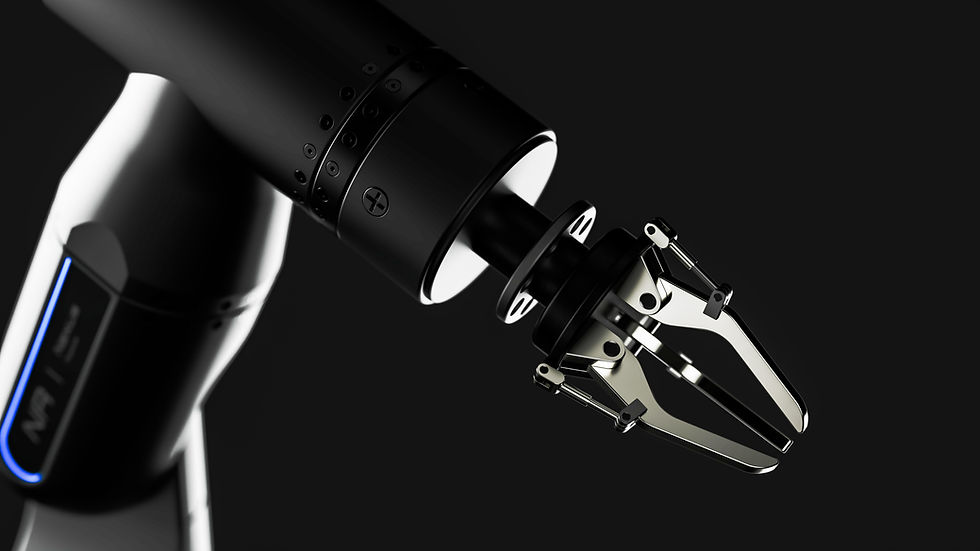NEXUS
INNOVATION MEETS AUTOMATION
SERVICES
Visualisation | 3D Modelling | Branding & Graphics
SECTOR
Robotics | Automation | Industry 4.0 | Smart Manufacturing
Robotic arms mark a transformative shift in industries ranging from manufacturing to healthcare, fundamentally reshaping the way tasks are performed with unparalleled precision and efficiency. As advancements in artificial intelligence, machine learning, and robotics have converged, robotic arms have evolved from basic automation tools to highly adaptable, intelligent systems capable of executing complex operations.
Through advanced 3D visualisation tools, dive into the world of Nexus and experience a revolutionary era in robotics—where cutting-edge design and unparalleled efficiency seamlessly merge. Robotic arms are meticulously crafted to boost productivity, streamline operations, and foster sustainability across diverse industries. Every movement is optimised to perfection, reducing waste, lowering energy consumption, and helping to pave the way for a greener, more sustainable future. Robotic arms don’t just represent the future of automation—it embodies a smarter, more efficient, and sustainable approach to innovation.
Promising a future of greater innovation, efficiency, and even entirely new industries.
Robotic arms thrive in environments that are hazardous or highly repetitive, enhancing safety while maximising productivity. More than just tools, they are catalysts for transformation, driving the evolution of entire industries. As technology advances, their potential to unlock new possibilities, redefine efficiency, and create groundbreaking opportunities across sectors is virtually limitless.

Experience the Nexus Robotic Arm Series
The Nexus robotic arm series comes to life through high-quality 3D visualisations and animations, offering an immersive view of its design and advanced functionality. Leveraging state-of-the-art tools, it showcases precision engineering and brings visionary concepts to life - ideal for product development, stakeholder presentations, and technological demonstrations.





How robotic arms are transforming industries
As technology advances at an unprecedented rate, the potential applications for robotic arms are becoming increasingly diverse and far-reaching. With every new breakthrough, these cutting-edge systems are unveiling new opportunities across various industries, reshaping the way we work, innovate, and engage with technology.
Agriculture
These advanced robots are designed to carefully pick delicate fruits like strawberries, apples, and grapes, using precise movements that reduce damage to the produce.





Smart harvesting, powered by robotics.
Equipped with AI and advanced sensors, robotic arms can assess fruit ripeness, pick only the best, and handle crops gently to preserve quality. Operating around the clock, they increase harvesting speed, reduce reliance on seasonal labour, minimise waste, and improve yield accuracy - making farming smarter, more efficient, and environmentally friendly.

Medical
Robotic arms are transforming medical sample testing by delivering unmatched precision, speed, and reliability in laboratories and diagnostic settings.



Precision. Consistency. Innovation in Every Test.
Equipped with precise motion control and advanced sensors, robotic arms can automatically dispense reagents, mix samples, and perform complex diagnostic tests with minimal risk of error or contamination. By automating routine, labour-intensive tasks, they deliver faster, more consistent, and reliable results.
Logistics
In fulfillment centers, robotic arms are used for sorting, packaging, and moving goods. They enhance efficiency by working alongside human workers to manage inventory and prepare orders quickly.




Streamlining logistics and ensuring accuracy at every stage of the supply chain.
Robotic arms mounted on Autonomous Guided Vehicles (AGVs) are revolutionising warehouse operations — efficiently picking, placing, and transporting goods with speed and precision. Their seamless integration creates agile, intelligent systems capable of managing complex workflows effortlessly. Powered by advanced AI navigation, AGVs deliver unmatched operational efficiency. Combined with industrial robotic arms, they enable fully automated material handling, sorting, and routing.

Automotive
Robotic arms are widely used for tasks like welding, painting, and assembling vehicle parts. Their precision ensures consistency and reduces human error in high-volume production lines.



Where human expertise meets robotic precision -
the future of automotive innovation begins.
Robotic arms have become essential to the automotive industry, transforming manufacturing processes across every stage of production. By automating complex tasks such as welding, painting, and parts handling, they deliver unmatched speed, precision, and consistency. Beyond enhancing efficiency, these systems improve workplace safety by taking on hazardous and physically demanding jobs, allowing human workers to focus on strategic, high-value tasks.
Electronics
In electronics manufacturing, robotic arms assemble intricate parts like circuit boards, screen displays, and microchips, improving efficiency and minimising defects.






In CAD (Computer Aided Design), bone rigging is a fundamental technique used to create dynamic, lifelike animations.
This process involves attaching a virtual "skeleton" (or bones) to a 3D model, allowing it to move and deform in a realistic way. Each bone in the rig acts like a joint or part of the model's structure, and by manipulating these bones, you can control the movement of the entire model.

The electronics and chip manufacturing industries demand advanced technology to produce intricate, high-performance components.
Robotic arms have become indispensable in automating critical tasks and ensuring consistent quality at every stage of production. By driving automation, enhancing precision, improving safety, and boosting productivity, they play a pivotal role in streamlining operations. While robotic arms are undeniably powerful tools that drive automation, human involvement is crucial for optimising their performance and ensuring their safe and effective operation. Humans bring creativity, adaptability, decision-making, and expertise to the table - elements that robots still cannot replicate.

Turning Vision into Reality.
3D visualisation is essential in transforming cutting-edge technologies, such as robotics and engineering, into clear, actionable concepts. It takes complex ideas and brings them to life, providing a powerful tool for design, communication, and decision-making.
In the rapidly evolving fields of robotics, AI, and machine learning, 3D visualisation empowers engineers and developers to gain a deeper understanding of system interactions, address design challenges, and enhance functionality with precision.
